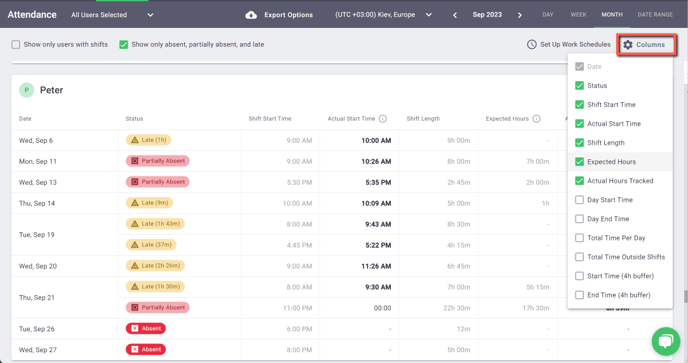The Attendance Report is available only when the Work Schedules feature is activated on the Company Settings page.
The Attendance Report only contains data when work schedules have been set up. You can learn how to set up work schedules here.
Configuring the report
There are many columns to choose from in this report and some of them might not be applicable to you; you can select which columns you want to see by clicking on Columns on the top right.

Report columns
Shift-related columns
The following columns focus on times within shifts.
- Status - the status of the shift such as Late or Present. See the “The Attendance Statuses” section below for more details.
- Shift Start Time - the shift start time selected on the Work Schedules page
- Actual Start Time - the earliest time worked during the shift. Time worked before the shift start time is not taken into account.
- If you are interested in the start time before the shift, you can see the earliest time worked on the day in the “Day Start Time” column. If shifts continue to the next day, you might want to look at the “Start Time (4h buffer)” column, which adds a 4h buffer before the shift start time when checking for the earliest time worked for the shift.
- Shift Length - the length of time between shift start and end times.
- Expected Hours - an optional value provided in the "Work Schedules" page to indicate how many hours are expected to be worked during the shift. It might be lower than the shift length because people might be expected to take breaks.
- Actual Hours Worked - the hours worked during the scheduled shift hours. Work done before the shift start time or after the shift end time is excluded.
- If you would like to see how much a user worked outside shifts in a day, please see the “Total Time Outside Shifts” column.
Day-related columns
The following columns are to provide context on how much a user worked on a calendar day, not only during scheduled shifts. You might want to look at these columns to see when and how much a user worked outside of their scheduled working hours.
- Day Start Time - the earliest time worked in the day in the selected time zone.
- Day End Time - the latest time worked in the day in the selected time zone.
- Total Time Per Day - the total time worked in the day in the selected time zone.
- Total Time Outside Shifts - the total time worked outside of the scheduled shifts in the selected time zone.
Additional columns for when shifts continue to the next day
If Day Start Time and Day End Time are not useful to you because shifts often continue to the next day, the following columns might be useful:
- Start Time (4h buffer) - the earliest time worked during the 4 hours before the shift start time (those 4 hours may run into the previous day). If a user didn’t start working before the shift start time, their start time within the shift is shown.
- End Time (4h buffer) - the latest time worked within 4 hours after the end of a shift (those 4 hours may run into the next day). If a user didn’t work after the scheduled end time, the end time within the shift is shown.
The Attendance Statuses
There are four attendance statuses in the report.
Present
This has different meanings, depending on whether a shift has a minimum number of required hours.
- If there are no minimum required hours: The user tracked at least one second of work in the first five minutes of their shift (If they didn’t track work during the first five minutes but did track work later in the shift, they’ll be either “late” or “partially absent” rather than “present”).
- If there are minimum required hours: The person tracked at least one second of work in the first five minutes of their shift AND worked for at least the minimum number of required hours.
Absent
No time was tracked during the shift.
Partially Absent
The person tracked some time during the shift, but less than their minimum required hours.
Late
A person tracked time during their shift, but they didn’t track time in the first five minutes after their shift started.
Notes:
- Users have a five-minute grace period during which they won’t be counted as late.
- If someone is both late and partially absent for the same shift, then their status is partially absent.
Shift Underway
When a shift is currently underway (has started but not yet finished), the shift's status will show as "Late" if the person was late. However, since the statuses Present, Absent and Partially Absent won't be known until the end of the shift, shifts that are currently underway will show a status of "Shift Underway" if the person isn't late.
A Few Additional Details
- For any shift that runs across midnight, the shift will only appear on the day it began, not on the day that it ends.
- Shifts that haven’t started yet won’t appear in the report.
- If a user has several shifts on one day, the shifts appear as separate rows in the report.